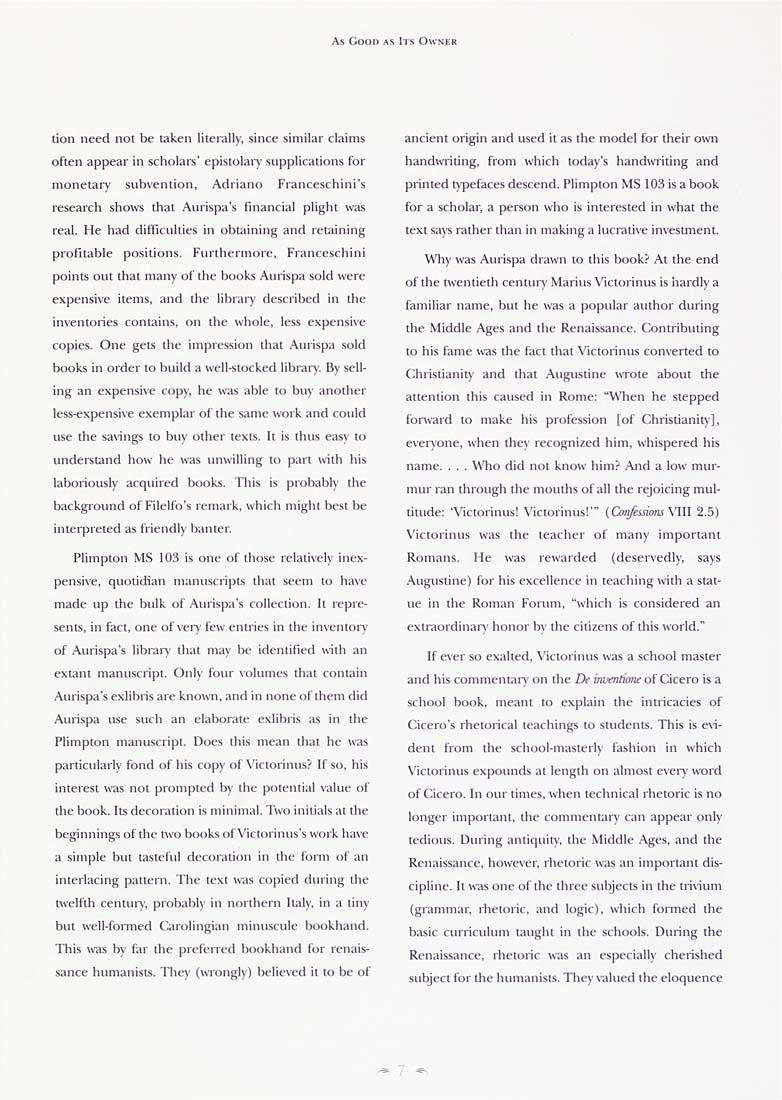Columbia Library columns (v.44(1995))
(New York : Friends of the Columbia Libraries. )
|
||
|
|
|
|
| v.44,no.1(1995:Winter): Page 7 |

As Good as Its Owner tion need not be taken literally, since similar claims often appear in scholars' epistolary supplications for monetary subvention, Adriano Franceschini's research shows that Aurispa's financial plight was real. He had difiiculties in obtaining and retaining profitable positions. Furthermore, Franceschini points out that many of the books Aurispa sold were expensive items, and the library described in the inventories contains, on the whole, less expensive copies. One gets the impression that Aurispa sold books in order to build a well-stocked library. By sell¬ ing an expensive copy, he was able to buy another less-expensive exemplar of the same work and could use the sa\'ings to buy other texts. It is thus easy to understand how he was umvilling to part \vith his laboriously acquired books. This is probably the background of Filelfo's remark, which might best be interpreted as friendly banter. Plimpton MS 103 is one of those relatively inex¬ pensive, quotidian manuscripts that seem to have made up the bulk of Aurispa's collection. It repre¬ sents, in fact, one of very few entries in the inventoiy of Aurispa's librar)' that may be identified with an extant manuscript. Only four volumes that contain Aurispa's exlibris are known, and in none of them did Aurispa use such an elaborate exlibris as in the Plimpton manuscript. Does this mean that he was particularly fond of his copy of Victorinus? If so, his interest was not prompted by the potential value of the book. Its decoradon is minimal. Two initials at the beginnings of the two books of Victorinus's work have a simple but tasteful decoration in the form of an interlacing pattern. The text was copied during the twelfth century, probably in northern Italy, in a tiny but well-formed Carolingian minuscule bookhand. This was by far the preferred bookhand for renais¬ sance humanists. They (wrongly) believed it to be of ancient origin and used it as the model for their own handwriting, from which today's handwriting and printed typefaces descend. Plimpton MS 103 is a book for a scholar, a person who is interested in what the text says rather than in making a lucrative investment. Why was Aurispa drawn to this book? At the end of the twentieth century Marius Victorinus is hardly a familiar name, but he was a popular author during the Middle Ages and the Renaissance. Contribudng to his fame was the fact that Victorinus converted to Christianit)' and that Augustine wrote about the attention this caused in Rome: "When he stepped fonvard to make his profession [of Christianit)], ever)'one, when the\' recognized him, whispered his name. . . . Who did not know him? And a low mur¬ mur ran through the mouths of all the rejoicing mul¬ titude: 'Victorinus! Victorinus!"' (Coiifessions \lll 2.5) Victorinus was the teacher of many important Romans. He was rewarded (deservedly, says Augustine) for his excellence in teaching with a stat¬ ue in the Roman Forum, "which is considered an extraordinar)' honor by the citizens of this world." If ever so exalted, Victorinus was a school master and his commentary on the De inventione of Cicero is a school book, meant to explain the intricacies of Cicero's rhetorical teachings to students. This is e\i- dent from the school-masterly fashion in which Victorinus expounds at length on almost ever)' word of Cicero. In our times, when technical rhetoric is no longer imporLint, the commentary can appear only tedious. During antiquity, the Middle Ages, and the Renaissance, however, rhetoric was an important dis¬ cipline. It was one of the three subjects in the trivium (grammar, rhetoric, and logic), which formed the basic curriculum taught in the scliools. During the Renaissance, rhetoric was an especially cherished subject for the himianists. They valued the eloquence ,- 7 -^ |
| v.44,no.1(1995:Winter): Page 7 |







